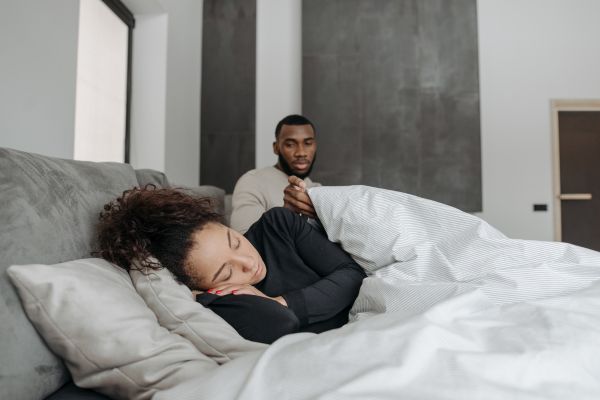In the realm of sleep and relationships, the dynamics of how couples choose to share a bed can be as diverse as the love they share. One intriguing and perhaps unconventional arrangement is when couples opt to sleep at opposite ends of the bed. This choice, while seemingly contrary to the stereotypical image of spooning and cuddling, can offer valuable insights into the intricacies of personal space, comfort, and intimacy within a partnership.
This article delves into the fascinating world of couples who sleep at opposite ends of the bed and find connection in the arrangement that prioritizes individual needs while nurturing the bond they share.
Couples Who Sleep at Opposite Ends of the Bed
Sleeping arrangements are a personal and unique aspect of every couple’s relationship. While many couples choose to sleep side by side, there are some who find comfort and preference in sleeping at opposite ends of the bed. This article explores the dynamics of couples who sleep at opposite ends of the bed, why they may choose this arrangement, and how it can impact their relationship.
Understanding the Dynamics
Couples who sleep at opposite ends of the bed have a sleeping arrangement that deviates from the traditional practice of sharing a single side. This arrangement often involves each partner occupying their own space on the bed, with a clear division in the middle.
Reasons for Sleeping at Opposite Ends
There can be various reasons why couples choose to sleep at opposite ends of the bed:
1. Personal Space
Some individuals naturally desire their personal space during sleep, and sleeping at opposite ends of the bed allows each partner to have their own area without feeling crowded or restricted.
2. Different Sleep Preferences
Couples may have different sleep preferences, such as varying temperatures, mattress firmness, or sleeping positions. Sleeping at opposite ends allows each partner to cater to their specific sleep needs, ensuring a more comfortable night’s rest.
3. Snoring or Restless Sleep
If one partner snores or has restless sleep, sleeping at opposite ends can help minimize disruptions and ensure both partners can get the quality sleep they need.
4. Physical Comfort
Couples with height or size differences may find it more comfortable to sleep at opposite ends to accommodate their body proportions and minimize discomfort.
Impacts on the Relationship
Sleeping at opposite ends of the bed can have both positive and negative impacts on a couple’s relationship:
1. Independence and Autonomy
This sleeping arrangement can provide a sense of independence and autonomy for each partner, promoting individuality within the relationship. It allows for personal space and a feeling of freedom during sleep.
2. Reduced Intimacy
One potential drawback of sleeping at opposite ends is the potential reduction in physical intimacy. The physical distance can create barriers to cuddling, touch, or spontaneous moments of connection.
3. Enhanced Sleep Quality
For couples who have sleep disturbances or incompatible sleep preferences, sleeping at opposite ends can result in improved sleep quality for both partners. This can lead to better overall well-being and functioning in daily life.
4. Communication and Compromise
Couples who choose this sleeping arrangement often need to communicate effectively and find compromises that work for both partners. This can foster healthy communication skills and a willingness to accommodate each other’s needs.
Finding the Right Balance
To maintain a healthy balance in a relationship where partners sleep at opposite ends of the bed, consider the following:
1. Open Communication
Regularly discuss the sleeping arrangement, ensuring that both partners feel comfortable and have their needs met. Address any concerns or challenges that may arise and be open to adjusting the arrangement if necessary.
2. Maintain Physical Intimacy
Although physical distance may be a part of the sleeping arrangement, prioritize physical intimacy during waking hours. Find moments for cuddling, intimate conversations, and bonding activities that strengthen the emotional connection.
3. Consider Compromises
Be open to compromise and flexibility. If one partner desires more closeness during sleep, find ways to meet halfway, such as snuggling before sleep or having designated cuddle time in the morning.
4. Revisit the Arrangement
As circumstances change or personal preferences evolve, it’s important to revisit the sleeping arrangement periodically. Check-in with each other and adjust as needed to ensure both partners feel satisfied and supported.
Conclusion
Couples who choose to sleep at opposite ends of the bed have their own unique dynamic that suits their individual needs and preferences. While it can provide personal space and promote better sleep quality, it’s important to be mindful of maintaining physical intimacy and open communication within the relationship.
By finding the right balance and being responsive to each other’s needs, couples can navigate this sleeping arrangement in a way that strengthens their connection and fosters a healthy relationship.
FAQs
1. Is it common for couples to sleep at opposite ends of the bed?
Sleeping arrangements vary among couples, and sleeping at opposite ends of the bed is a personal preference that may not be as common as sharing one side. However, it is a valid and legitimate choice for couples who find it suits their needs.
2. How can couples maintain intimacy when sleeping at opposite ends?
Maintaining intimacy in this sleeping arrangement requires intentional efforts outside of bedtime. Find opportunities for physical touch, prioritize quality time together, and openly communicate about emotional needs and desires.
3. Can sleeping at opposite ends of the bed be a sign of relationship issues?
Not necessarily. Couples may choose this arrangement for various reasons that have nothing to do with relationship issues. However, if the sleeping arrangement becomes a source of tension or conflict, it may be helpful to explore underlying concerns with open communication or seek professional guidance.
4. Should couples who sleep at opposite ends of the bed try to change their arrangement?
There is no one-size-fits-all answer to this question. If both partners are comfortable and satisfied with the arrangement, there may be no need to change. However, if either partner desires more physical closeness or feels disconnected, it may be worth exploring alternative arrangements or finding compromises that meet both partners’ needs.
5. Can couples alternate between sharing a side and sleeping at opposite ends of the bed?
Absolutely. Couples can explore different sleeping arrangements based on their needs and preferences. Alternating between sharing a side and sleeping at opposite ends can provide variety and accommodate changing circumstances or desires.
In the end, what matters most is that couples find a sleeping arrangement that promotes restful sleep, respect for personal boundaries, and emotional connection within their relationship. Whether they choose to sleep side by side or at opposite ends of the bed, open communication, understanding, and mutual support are essential for maintaining a healthy and fulfilling partnership.







